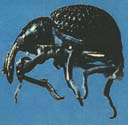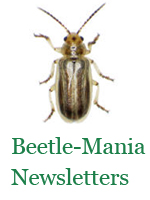 Cyrtobagous salviniae Calder & Sands
Cyrtobagous salviniae Calder & Sands
[Coleoptera: Curculionidae]
Scientific name: This species has been confused with Cyrtobagous singularis (Hustach) in the literature (Sands 1983). Some of the work on biology (Room et al. 1981, Forno et al. 1983) of C. singularis actually applies to C. salviniae.
Biology | History | Status | Management | Weeds | Literature | Links
Forno et al. (1983) report the biology of this weevil studied in the native habitat of South America. They found that adults are light brown when they first emerge but darken to black in 5 days. Adults are sub-aquatic and can be found beneath young leaves, within leaves or in the roots of salvinia. Adults of this tribe, Bagoini, respire, when resting or feeding below the water surface, with the aid of air bubbles or air tapped from plant stems. The preoviposition stage is 6-14 days. Eggs are laid singly in stem cavities produced by the adult feeding. Oviposition took place only when salvinia was in contact with the water. Females laid one egg every 2-5 days over a 60 day study period. Larvae feed on young terminal buds and enter the leaf bud tunneling inside after 3-14 days of surface feeding. Three larval instars are completed before development is complete. The average developmental time for larvae is 23 days at 25.5EC. Pupation takes place in a cocoon in contact with living plants. Most cocoons are found below the leaves or within the root mass. Prepupae and pupae are found in cocoons and average 12.6 days at 25.5EC. Temperature extremes of 19EC and 37EC. decrease oviposition and reduce longevity.
This weevil was collected in Brazil and Argentina for the biological control of the giant salvinia. Studies in Australia (Room et al. 1981), Sri Lanka (1986), South Africa (Cilliers 1991), and Papua, New Guinea (Mitchell and Rose 1979) proved to be an effective biological control agent for Salvinia molesta. This weevil is established in Florida where a resident population feeds on Salvinia minima when S. molesta is not available. The introduction into Florida was probably accidental.
This weevil has been released in Texas since the discovery of Salvinia molesta.
This weevil prefers to feed on Salvinia molesta but can feed and reproduce on Salvinia minima. Many other plants were tested and determined not to be a suitable host for this weevil (Forno et al. 1983).
Cilliers, C. J. 1991. Biological control of water fern, Salvinia molesta (Salviniaceae), in South Africa. Agri. Ecosystems Environ. 37: 219-224.
Forno, I. W., D. P. A. Sands, W. Sexton. 1983. Distribution, biology, and host specifity of Cyrtobagous singularis ( Coleoptera: Curculionidae) for the biological control of Salvinia molesta. Bull. Ent. Res. 73: 85-95.
Mitchell, D. S., and D. J. W. Rose. 1979. Pest. Agric. News Summary. 27: 171-177.
Room, P. M., K. L. S. Harley, I. W. Forno, and D. P. A. Sands. 1981. Successful biological control of the floating weed salvinia. Nature, Lond. 294: 78-80.
Sands, D. P. A. 1983. Identity of Cyrtobagous sp. (Coleoptera: Curculionidae) introduce into Australia for Biological Control of Salvinia. J. Aust. Ent. Soc. 22: 200.

